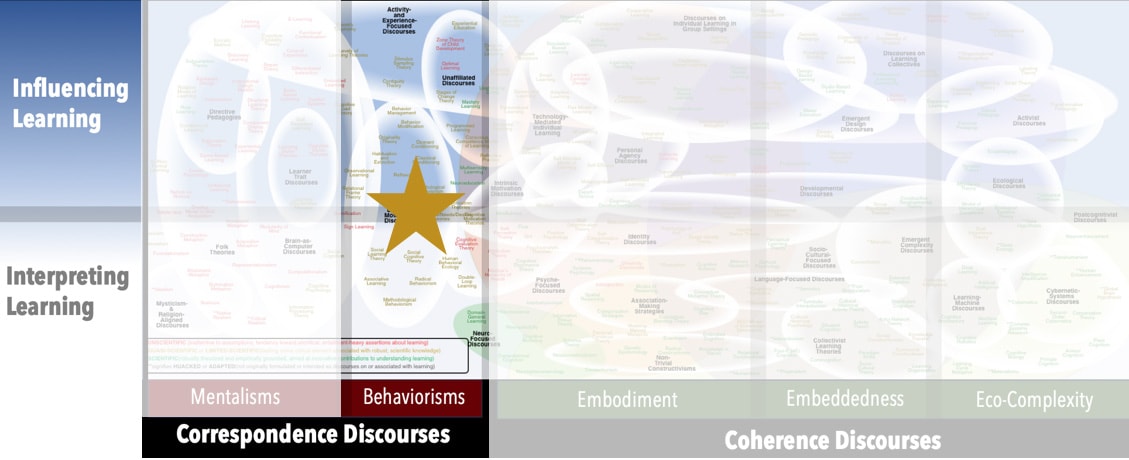AKA
Pavlovian Conditioning
Pavlovian Learning
Respondent Conditioning
Type I Conditioning
Type S Conditioning
Focus
Affecting reflexes and other involuntary behaviors by manipulating environmental stimuliPrincipal Metaphors
- Knowledge is … repertoire of behaviors
- Knowing is … behaving (triggered by stimuli)
- Learner is … an organism (individual-in-context)
- Learning is … changes in behavior (specifically: associating stimuli with reflexive responses)
- Teaching is … classical conditioning (training the subject to manifest a reflexive response when a stimulus is presented)
Originated
1890sSynopsis
Classical Conditioning and Operant Conditioning are two branches of Behaviorisms that are more properly understood as advice on teaching than as theories of learning. Both are concerned with manipulating and managing behaviors controlled by environmental stimuli, although they focus on different categories of behavior and employ different methods. Classical Conditioning is concerned with reflexive, nonvoluntary behaviors that are not under the learners’ control (e.g., salivation), and it deals with training learners to use neutral stimuli (e.g., a bell sound, versus the value-laden rewards and punishments within Operant Conditioning) to elicit those behaviors. The principal strategy is to present the stimulus when the target behavior occurs so that the learner forms an association between them. Types of stimuli and responses include:- Categories of Stimuli:
-
Ambiguous Stimulus – an object of perception that can be easily interpreted in multiple ways and/or trigger a variety of responses
- Neutral Stimulus – a stimulus that does not trigger a response
- Unconditioned Stimulus – a stimulus that triggers a natural, Unconditioned Response
- Conditioned Stimulus – a stimulus that, after a training process, triggers a response that’s similar to one triggered by an Unconditioned Stimulus
-
- Categories of Responses:
- Conditioned Response – a response triggered by a Conditioned Stimulus
- Unconditioned Response – a natural response that’s triggered by an Unconditioned Stimulus
- Habit (S–R Habit) – in the context of Classical Conditioning, a conditioned association. That is, in this context, a Habit is the basic unit of learning. Associated notions include:
- Habit-Family Hierarchy (Response Hierarchy) (Clark Hull, 1950s) – different degrees of Habit strength, in reference to situations in which an organism has learned multiple distinct responses to the same stimulus
- Intervening Variables (Clark Hull, 1950s) – factors that are specific to a learner/organism that must be taken into account for accurate predictions of how effective a conditioning process will be
- S–S Learning (Stimulus–Stimulus Learning; Stimulus Substitution Theory) – when one stimulus comes to stand in for another (e.g., a bell standing in for food) in triggering a nonvoluntary behavior (e.g., salivation)
- Sensory Preconditioning – the associating of two Neutral Stimuli prior to a conditioning process. When a response has been conditioned to one of those stimuli, the other stimuli may also trigger it.
- Two-Term Contingency – in Classical Conditioning, the relationship between the two antecedent stimuli – that is, the Unconditioned Response and the Unconditioned Stimulus. (Compare: Three-Term Contingency of Operant Conditioning.)
- Associative Bias – variations in the likelihood and/or ease of conditioning a response due to inherent relationships between certain stimuli and certain responses
- Autonomic Learning – learning involving the modulation of nonconsious functions, such as heart rate. (Contrast with Visceral Learning, under Operant Conditioning.)
- Higher-Order Conditioning (Second-Order Conditioning) – when an already-conditioned stimulus (e.g., a bell triggering salivation) is used as the basis to condition a response from another stimulus (e.g., a hand motion with the bell)
- Irradiation Theory of Learning (Ivan Pavlov, 1890s) – a conjecture intended to serve as a neural basis for Classical Conditioning, positing that (i) a stimulus activates specific brain cells, (ii) such activation spreads among other cells (metaphorically, it irradiates), and (iii) an association happens when that spread overlaps with the spreading activation of another stimulus
Commentary
See Behavorisms for global critiques, especially as this theory relates to human learning. The main issue with Classical Conditioning, with regard to formal education, is that very few curriculum goals fall into the category of nonvoluntary responses. That said, Classical Conditioning has proven especially effective for treating post-traumatic stress disorder, various phobias, and other emotionally taxing conditions.Authors and/or Prominent Influences
Ivan Pavlov; John B. WatsonStatus as a Theory of Learning
Within the very limited scope of reflexive behaviors, Classical Conditioning is a theory of learning.Status as a Theory of Teaching
Classical Conditioning is a more appropriately regarded as a theory of teaching than a theory of learning. With its focus on manipulating behavior, Classical Conditioning falls among mechanistic conceptions of teaching associated with Correspondence Discourses of learning.Status as a Scientific Theory
The foci, processes, and interpretations of Classical Conditioning are clearly articulated and supported by a substantial body of uncontradicted evidence. However, Classical Conditioning falls well short of a theory that can inform activity in formal education, and so in our analysis is classified as limited theory.Subdiscourses:
- Ambiguous Stimulus
- Associative Bias
- Autonomic Learning
- Conditioned Response
- Conditioned Stimulus
- Habit (S–R Habit)
- Habit-Family Hierarchy (Response Hierarchy)
- Higher-Order Conditioning (Second-Order Conditioning)
- Intervening Variables
- Irradiation Theory of Learning
- Neutral Stimulus
- S-S Learning (Stimulus–Stimulus Learning; Stimulus Substitution Theory)
- Sensory Preconditioning
- Two-Term Contingency
- Unconditioned Response
- Unconditioned Stimulus
Map Location

Please cite this article as:
Davis, B., & Francis, K. (2023). “Classical Conditioning” in Discourses on Learning in Education. https://learningdiscourses.com.
⇦ Back to Map
⇦ Back to List
